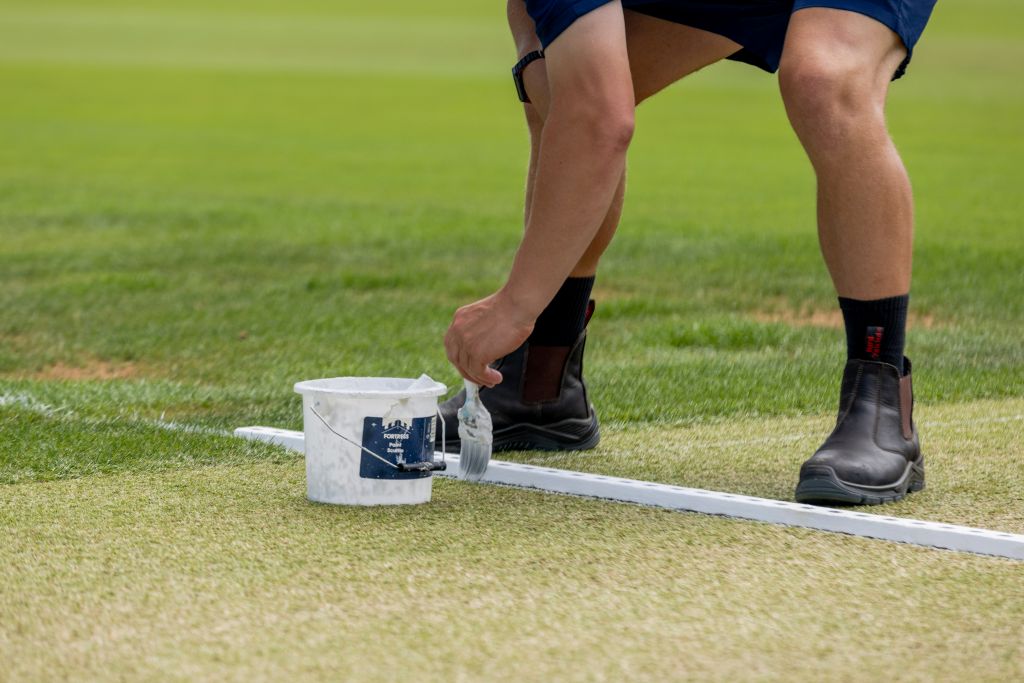
August brings challenges for grounds teams as dry weather and heavy use test pitch health.
This month, focus on careful repair in cricket, smart water management all-round and gentle maintenance to keep surfaces safe and playable. These tips will help you manage turf stress and protect your pitches through the season’s demands.
Here are some essential tasks to focus on this month:
- GENERAL CRICKET GROUND MAINTENANCE
Continue to prepare the pitches and outfields following guidelines from the GMA toolkit for the remaining games. Now is the time to start planning the end of season square renovation. If you’re using contactors, make sure the booking is confirmed and the materials being used are correct. If you’re carrying out the renovation in-house, ensure all materials (Loam, seed, fertiliser) are ordered and all equipment (scarifier, lute, spreaders) are all in working order and start arranging some volunteers to help with the renovation. More information here. - REPAIRING CRICKET ENDS
Make an assessment on whether or not the ends of the pitch need repairing. This is not always the case, especially if the game was shortened - and it often depends on the bowlers, the soils in your pitch and the moisture content of the soil. Here's further guidance on repairing pitch ends.
Encourage players to avoid scratching pitches. Batters shouldn’t overmark guards, bowlers and keepers should use markers or spray paint instead of scraping. Ground staff can support by drawing clear crease-to-crease lines for leg, middle and off. - CLEANING THE CRICKET PITCH
After a game, check the pitch for loose spikes or debris that could damage machinery. Sweep and collect loose soil and plant material - grass goes to the clippings pile, soil can be reused for repairs or wet areas. A rotary roller mower can help clean, but sweep and keep soil from the ends first. Debris often spreads beyond the pitch. - PITCH PREPARATION - RUGBY UNION
Check goalposts and sockets for safety - neglect can cause avoidable injuries. Continue regular mowing and irrigate in line with local guidance as needed to maintain the pitch. Initial marking may be required unless lines have been continuously marked through the summer. One way to do this is with a GPS linemarker which will ensure that lines are straight and accurately measured before the start of the season. - MANAGING WATER IN A DROUGHT
With hosepipe bans and droughts affecting many UK regions, grounds teams must conserve water while keeping pitches safe and playable. Raise mowing height, avoid cutting dormant grass and water only key areas like goalmouths. Irrigate early or late to reduce evaporation and use covers sparingly. For cricket pitches, use covers to retain and deepen water infiltration. Harvest rainwater where possible and communicate surface limits clearly. Further guidance can be found here. - LINE MARKING
Keep line marking sharp with regular overmarking. Use a safe, durable paint to maintain clear, visible lines. Avoid heavy applications in hot, dry weather to prevent scorching. Always mark on a well-prepared surface, and overmark lightly to refresh lines without damaging the turf. - HARROWING/GROOMING
Only carry out harrowing or grooming in suitable conditions - perform this operation lightly, rather than aggressively at this time of year to help ensure levels following any renovation works or dressing remain suitable and to circulate air around the grass sward. Avoid aggressive operations in dry conditions though, as it can stress the turf. With winter sports, natural thinning will occur when play increases, however, this operation can be performed to reduce disease pressures and remove debris. Combine grooming with regular mowing, or brushing to maintain a healthy, well-kept pitch. - AERATION
When conditions allow, once the surface and soil soften, carry out light aeration to relieve compaction and improve water and air movement. Avoid aerating in very dry or hard conditions, as it can cause damage. Focus on high-wear areas and follow up with brushing or light rolling to maintain surface quality. - PLANNING FOR AUTUMN OPERATIONS
August presents an opportunity to look further ahead and assess the current condition of our winter sports pitches, and proactively plan for any required seasonal operations that might be necessary heading into the autumn. It’s important to be proactive with this planning and ensure funds are available for materials or contractor engagement. Overseeding, decompaction, a light top dressing or an application of a controlled release fertiliser may be required to sustain the pitch through the winter when conditions are challenging - now is the time to assess, ringfence budgets and plan for these remedial works.
For more expert advice
Need more guidance on pitch care? Visit the GMA Toolkit for detailed resources and tips tailored to your needs: resources.thegma.org.uk.
Get more from a GMA Membership
As a GMA member, you gain access to invaluable resources to support your grounds maintenance schedule. One standout benefit is our Ask the Expert service, offering one-to-one expert advice tailored to your specific challenges and goals.
Membership also unlocks a wealth of additional perks, including discounted rates on training courses and events, exclusive access to the brand-new Member Assistance Programme, and discounts from high street retailers!

















